Inside The New York Botanical Garden
Posted in Members, Photography, Wildlife on April 5 2011, by Patricia Gonzalez
You do not have to leave the five boroughs of New York to see wildlife. In fact, you’re only a train, subway, or bus ride away!
For the last three years that I have been a Member, I have had the pleasure of photographing different members of the animal kingdom at The New York Botanical Garden. The garden is a wildlife photographer’s dream. Within the Garden’s 250-acres you will find a forest, wetlands, streams, and two lakes–each one home to all manner of creatures–from cardinals to wild turkeys, from rabbits to red-tailed hawks, from mallards to muskrats. One can easily go through an entire camera battery (or two) trying to shoot them all (with your camera, of course).
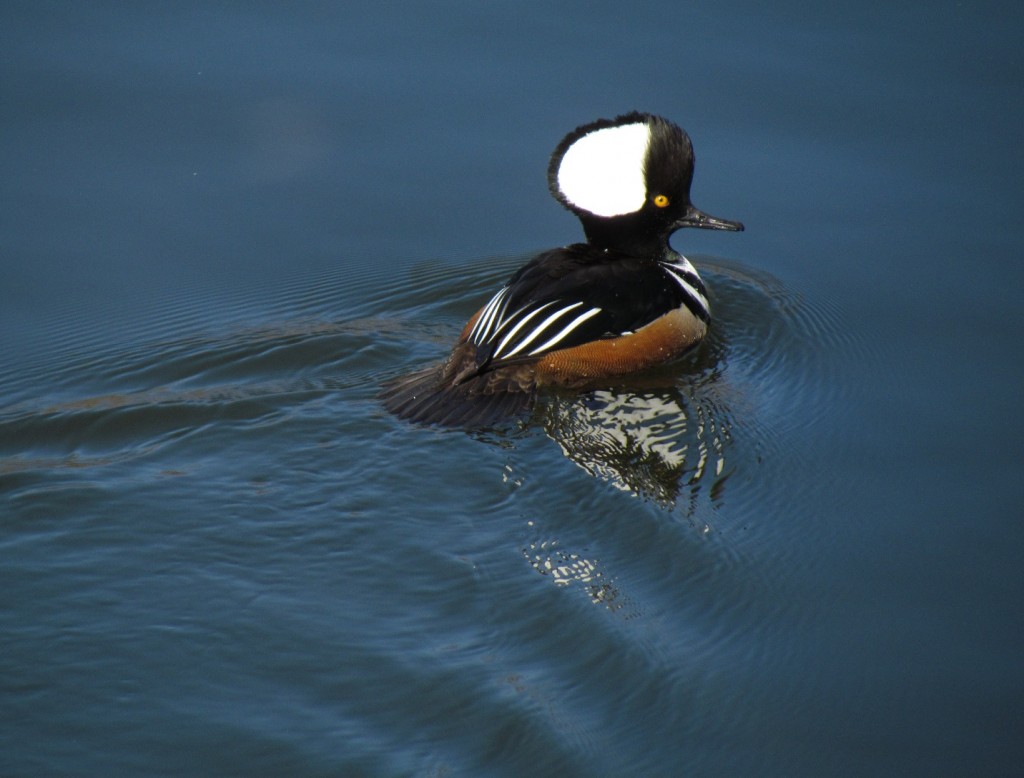
Here is an example of one of my recent mornings taking photos at the Garden:
Several weeks ago, I was walking down Azalea Way which is one of the garden’s main roads with camera in hand. To my left was the edge of the Native Forest and to my right the Azalea Garden. I was talking on my cellphone when I noticed the distinctive silhouette of a red-tail hawk on a tree to my right, just before Azalea Way meets with the Stone Mill Road.
I told the person on the other end that I’d have to call them back and switched my phone to vibrate so that if it rang, the sound wouldn’t scare the hawk away. I tip-toed ahead to a point where the sun was to my back and began shooting. The hawk stayed there for a bit and pretty soon I was right below him. I kept on shooting. After about five minutes, he crouched down and I knew he was going to take off. He then leaped right over me. For the second that it took him to do that he was only about four feet above my head. He glided on to the other side of the road, over the wooden fence with his talons extended, and landed on the forest floor with a light thud. I assumed that he had caught something, so I waited for the meal to begin. When a red tail captures prey, they will typically begin looking around, darting their head left and right. As the hawk was doing this with has his back to me, I slowly moved in closer all the while shooting between the fence posts.
Sometimes a young hawk will mistake an inanimate object for prey, which is what I think happened here. Eventually realizing that there was nothing there, he took a few steps and scrunched down as if to fly off again. Instead, he hopped on to the fence. I eased closer until I was about 15 feet away. That’s when I shot this. Ladies and gentlemen, look into the eyes of the natural world. He was even nice enough to let me shoot some video. As you can see, vehicles and distant sirens don’t seem to phase him either.
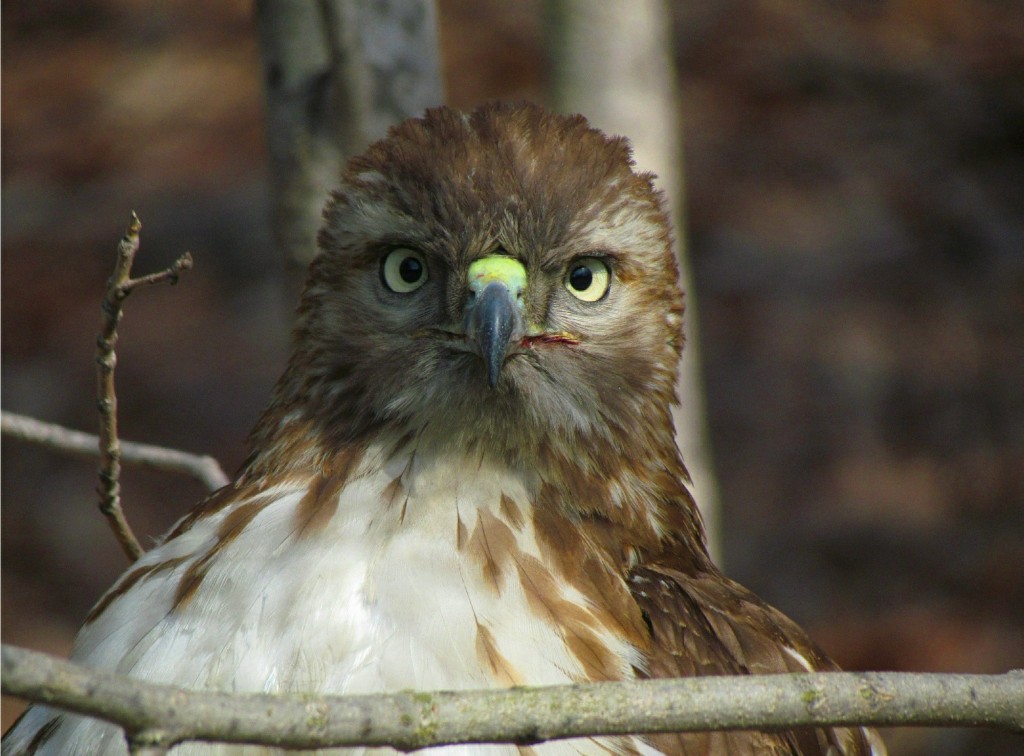
I shot about 50 photos while he was on that wooden fence. I’d never been this physically close to a red-tail before. I could see the color of his eyes, the detail in his feathers, his talons. I was truly in awe of this winged hunter. Further up Azalea Way I could see a group of four talking loudly. The hawk turned his head to look at them and I knew he was about to leave, so I just kept shooting. Seconds later he took off. I then ran home to look at the photos on my computer. It was there that I noticed the blood on his beak, most likely from a previous meal.
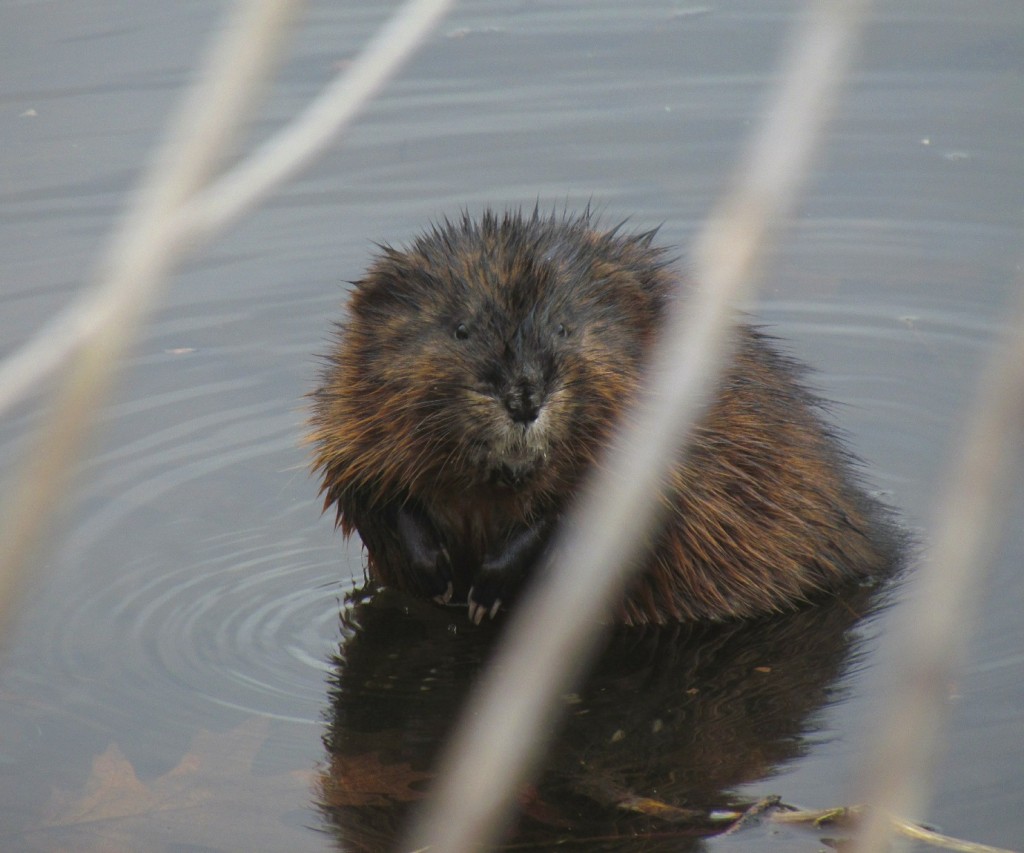
This was just one of the many events of nature that I’ve been blessed to witness during my photographic adventures at the Garden. Looking into the eyes of that magnificent raptor is something that will stay with me for the rest of my life. I encourage all photographers–amateur or pro, wildlife or scenic–not just to visit the Garden, but to become a Member. For the cost of an annual membership, you get unlimited entry to the grounds, the Conservatory, the exhibits in the Library Building, and all the other wonderful events that take place there throughout the year. Just don’t forget to bring your camera!
Next up: Pat gives us some practical tips for getting the most out of your photographic safari at the Garden. Stay tuned!
Posted in Photography on January 5 2011, by Plant Talk
For preening, don’t you think?

Red-Tailed Hawk on the roof of the Enid A. Haupt Conservatory (photo by Ann Rafalko)
Posted in Around the Garden on January 3 2011, by Plant Talk
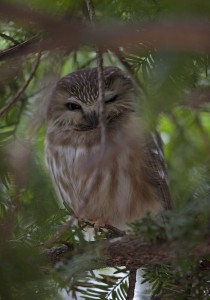 In what has become an annual holiday tradition, a group of intrepid bird watchers gathered at The New York Botanical Garden early on the day after Christmas (and just ahead of the Boxing Day Blizzard) to survey the Garden’s avian residents. Led by Steve Nanz, the group fanned out over the Garden’s 250-acres to count our feathered friends. In the end, the annual census was called early on account of the snow.
In what has become an annual holiday tradition, a group of intrepid bird watchers gathered at The New York Botanical Garden early on the day after Christmas (and just ahead of the Boxing Day Blizzard) to survey the Garden’s avian residents. Led by Steve Nanz, the group fanned out over the Garden’s 250-acres to count our feathered friends. In the end, the annual census was called early on account of the snow.
Despite that, the group still managed to spot 36 species, and a few rare birds, the highlight being a beautiful little Saw-whet Owl (pictured at right).
See the complete survey results below.
Posted in Wildlife on May 12 2010, by Plant Talk
Colorful Gems Spotted on Bird Walks During Spring Migration
 |
Debbie Becker leads a free bird walk at the Garden every Saturday from 11 a.m. to 12:30 p.m. beginning at the Reflecting Pool in the Leon Levy Visitor Center.
Photos of scarlet tanager and black-and-white warbler: Debbie Becker
|
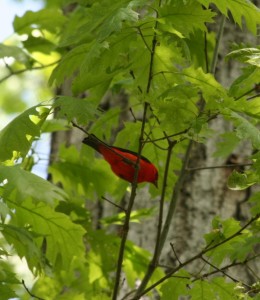 The spring bird migration is in full swing at the Garden. Recent bird walks have been a treat to the eyes and ears. Warblers are everywhere!
The spring bird migration is in full swing at the Garden. Recent bird walks have been a treat to the eyes and ears. Warblers are everywhere!
Warblers are small, colorful birds that migrate from areas of Central and South America to northern points in Canada and the United States. Once there, they build nests, reproduce, raise young, and then migrate back south in the fall.
Warblers are insect eaters and arrive just in time to feast on newly hatched insect larva. The warblers pass through the New York area mid-April to mid-May. Their beautiful songs and colorful feathers are enough to make any birder dizzy with delight.
This year searching for warblers is especially difficult because the trees bloomed earlier than usual due to the summer-like weather we had in April. With all the leaves on the trees, it is hard to find the songbirds as they dart about foraging for food. But diligence pays off. On our walks we’ve been treated to wonderful sightings, including the blackburnian warbler, a beautiful bird with an orange “fire throat.” All of the birders oohed and aahed as they strained their necks to see its throat—more orange than orange should be.
Read More
Posted in Wildlife on December 11 2009, by Plant Talk
 |
Debbie Becker leads a free bird walk at the Garden every Saturday from 11 a.m. to 12:30 p.m. beginning at the Reflecting Pool in the Leon Levy Visitor Center.
|
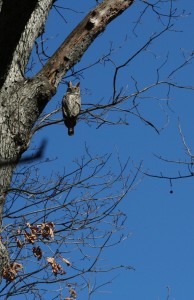 It’s that time of year again, when all the deciduous leaves have fallen and the bare tree limbs leave exposed the birds of the Forest. As you walk the Forest path you are reminded of the Native Americans who used the Forest as hunting grounds—along the trail by the Bronx River you will even pass the Bear Den, a cave believed to have been used by Native Americans while hunting.
It’s that time of year again, when all the deciduous leaves have fallen and the bare tree limbs leave exposed the birds of the Forest. As you walk the Forest path you are reminded of the Native Americans who used the Forest as hunting grounds—along the trail by the Bronx River you will even pass the Bear Den, a cave believed to have been used by Native Americans while hunting.
One of the most elusive figures in the NYBG Forest is the great horned owl, a large bird with tuft-like ears, cat-like eyes, and sharp claws. It is a monster of a bird, and it is the most sought-after species on our weekly walk.
Native Americans believed their deceased loved ones’ souls passed into the bodies of great horned owls. The owl was sacred to them and never hunted. Today we still hold the owl in reverence. It is a majestic, elusive creature that conceals itself in conifers during the day and hunts at night.
We’ll likely see this bird during our annual “unofficial” Christmas Bird Count tomorrow, in which we document the numbers of species and individual birds we see from 11 a.m. to 1 p.m. (The official Christmas Bird Count of the National Audubon Society, the 86th Bronx-Westchester Count, which includes the Botanical Garden, is on Sunday, December 27. Audubon conducts other counts over a three-week period all over North America and beyond.)
Read More
Posted in Programs and Events, Wildlife on September 3 2009, by Plant Talk
Join Debbie Becker in Looking for Early Migrants
 |
Debbie Becker leads a free bird walk at the Garden every Saturday from 11 a.m. to 12:30 p.m. beginning at the Reflecting Pool in the Leon Levy Visitor Center.
|
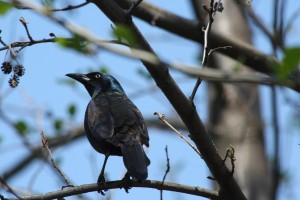 While the spring migration is exciting because of the colorful warblers that come through, the fall migration is much more spectacular in other ways. The warblers pass through again, but in drabber colors.
While the spring migration is exciting because of the colorful warblers that come through, the fall migration is much more spectacular in other ways. The warblers pass through again, but in drabber colors.
But it is the hawks, owls, harriers, ospreys, eagles, sparrows, swifts, swallows, and shorebirds on the move that attract most of the attention of bird watchers. The migration begins in late July, when the shorebirds begin showing up on coastal beaches. Osprey follow as they move south to open water. By mid-to-late August we see other species also migrating such as dragonflies and monarch butterflies. By September, the skies will be filled with their movement as well as of swifts and swallows.
As the last days of summer approach in mid-September and heat thermals rise off the Earth, the hawk migration will be in full swing. The hawks use the warm thermals to soar and conserve energy. A good thermal can allow a hawk to coast for miles. Broad-winged hawks are notorious for gliding on thermals in groups of thousands, known as “kettles,” during their migration from North America to South America.
Ruby-throated hummingbirds frequent the Garden during September as the jewelweed comes into bloom, filling their bellies with sweet nectar for the return trip to their wintering grounds. A hummingbird can fly nonstop up to 24 hours and almost 600 miles on stored fat.
Read More
Posted in Programs and Events, Wildlife on May 29 2009, by Plant Talk
Spring Brings Special Sightings
 |
Debbie Becker leads a free bird walk at the Garden every Saturday from 11 a.m. to 12:30 p.m., beginning at the Reflecting Pool in the Leon Levy Visitor Center. The last one for the season will be June 27.
|
Three fuzzy heads can be seen bobbing up and down in the red-tailed hawk nest. Just like Central Park’s Pale Male and Lola, our red-tails have made a neat little “cliffside” home at the top of a structure—in this case the Library building. It is interesting to watch mom and pop fly in with food to feed the babies. The hawks’ diet consists mainly of small mammals (such as squirrels and chipmunks) and birds, keeping the balance of nature in check. The female red-tail seems to find mockingbirds a special treat and has resorted to robbing mockingbird nests. Recently, we saw the red-tail perched atop the Watson Building with a baby mockingbird in her talons and mother mocker desperately trying to get mother hawk to free her prey. The mocker aggressively attacked the hawk, but in the end the hawk had a meal for her babies and the mocker went home to an empty nest. It is the circle of life.
While searching for warblers in the Forest we were treated to a very rare sight at this time of year: Our well-hidden female great horned owl flew from her perch followed by her fledgling. We were able to follow the mature owl to a new perch but lost the young owl in the leaves. As we watched the mom settle in, she kept looking around for her baby. Suddenly she looked forward and began to hoot. Then she turned her head right and hooted and then left and hooted. I guess she heard the young owl reply, because she closed her eyes and seemingly went to sleep.
 As the warbler numbers begin to dwindle, the birds having moved on to northern climes, we are grateful for another wonderful migration. Most of us were treated to the sightings of warblers such as black-throated blue, black-throated green, northern parula, Tennessee, chestnut-sided, bay-breasted, American redstart, common yellowthroat, yellow, prothonotary, and ovenbird. We also had warbling, red-eyed, and blue-headed vireos and a long list of other spectacular birds: Baltimore oriole, scarlet tanager, rose-breasted grosbeak, wood thrush, veery, hermit thrush, gray catbird, brown creeper, house wren, rough-winged swallow, bank swallow, tree swallow, chimney swift, eastern kingbird, great blue heron, great egret, night-heron, green heron (in full breeding plumage, see above photo, courtesy Debbie Becker), cormorant, wood duck (adults with 11 babies), mallard (adults with 12 babies) indigo bunting, cedar waxwing, savannah sparrow, ruby-throated hummingbird, eastern towhee, and northern flicker.
As the warbler numbers begin to dwindle, the birds having moved on to northern climes, we are grateful for another wonderful migration. Most of us were treated to the sightings of warblers such as black-throated blue, black-throated green, northern parula, Tennessee, chestnut-sided, bay-breasted, American redstart, common yellowthroat, yellow, prothonotary, and ovenbird. We also had warbling, red-eyed, and blue-headed vireos and a long list of other spectacular birds: Baltimore oriole, scarlet tanager, rose-breasted grosbeak, wood thrush, veery, hermit thrush, gray catbird, brown creeper, house wren, rough-winged swallow, bank swallow, tree swallow, chimney swift, eastern kingbird, great blue heron, great egret, night-heron, green heron (in full breeding plumage, see above photo, courtesy Debbie Becker), cormorant, wood duck (adults with 11 babies), mallard (adults with 12 babies) indigo bunting, cedar waxwing, savannah sparrow, ruby-throated hummingbird, eastern towhee, and northern flicker.
Read More
Posted in Programs and Events, Wildlife on March 27 2009, by Plant Talk
Saying Hello to New Arrivals and Goodbye to a Friend
 |
Debbie Becker leads a free bird walk at the Garden every Saturday from 11 a.m. to 12:30 p.m., beginning at the Reflecting Pool in the Leon Levy Visitor Center.
|
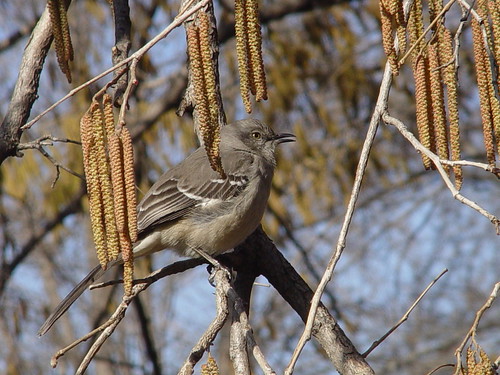 Spring has sprung at NYBG. The phoebe, spring’s harbinger, has arrived. A beautiful phoebe was spotted down by Twin Lakes bobbing its tail and calling. Ruby-crowned kinglets, brown creepers, and a juvenile eastern kingbird were also spotted on last Saturday’s walk.
Spring has sprung at NYBG. The phoebe, spring’s harbinger, has arrived. A beautiful phoebe was spotted down by Twin Lakes bobbing its tail and calling. Ruby-crowned kinglets, brown creepers, and a juvenile eastern kingbird were also spotted on last Saturday’s walk.
Perhaps the best indication of spring is seeing the mating rituals that some of the birds perform. The male mockingbird does a dance on the lawn by extending his wings and flashing his white stripes. The female, who looks exactly like the male, is an onlooker who watches from afar. She may judge him on his display or wait further to hear the kaleidoscope of songs that emanate from his vocal cords when he is high atop a tree. Many mockingbirds mock sounds they hear in their vicinity. NYBG mockers often imitate the other birds at NYBG along with alarm systems from cars and sometimes screeching—like the sounds a child might make. The female only mocks in the fall, leaving the spring air open for her suitor’s song.
Read more about birds at the Garden and check out all of this weekend’s programming after the jump.
Read More
Posted in Programs and Events, Wildlife on February 20 2009, by Plant Talk
Birders Treated to Uncommon Sightings and Start of Mating Season
 |
Debbie Becker leads a free bird walk at the Garden every Saturday from 11 a.m. to 12:30 p.m., beginning at the Reflecting Pool in the Leon Levy Visitor Center.
|
 The other day I watched two male house sparrows competing for the attention of a female bird who seemed totally disinterested in their mating dance. With tail feathers extended they jumped, hopped, and vied for her attention. She seemed distracted and eventually flew away leaving the two male birds confused and looking for another female to shower with attention.
The other day I watched two male house sparrows competing for the attention of a female bird who seemed totally disinterested in their mating dance. With tail feathers extended they jumped, hopped, and vied for her attention. She seemed distracted and eventually flew away leaving the two male birds confused and looking for another female to shower with attention.
February marks the beginning of spring for many birds. It is the start of their mating season. Even though the temperature is hovering around 30 degrees and remnants of snow are on the ground, for birds love is in the air. Perhaps Valentine’s Day was created with birds in mind. What reasonable human really thinks about love during the coldest month of the year? Roses wilt, balloons deflate, and chocolate gets hard in the February frost. But for birds, their warm little bodies and courtship rituals begin to stir as tiny buds form on early blooming trees.
Bird watching has long been regarded as an act of love. For those of us who bundle up in the winter and drudge along snow-laden pathways in the Garden, it is a yearning of the heart that keeps us warm and drives us on. Our quest to see the owls, hear the mourning doves cry, watch the red-tailed hawks soar above, and feed the chickadees from our palms are all acts of unselfish and undying love. What else would motivate us to wake up early on a Saturday morning, don layers of clothes, gloves, boots, hand warmers, hats, and scarfs to brave the cold winds of February and March to go birding.
This year especially, the birding lovebug has bitten many. Because of the global changes and an unusually cold winter, many birds that normally are residents of Canada and the northeastern United States have been driven south by snow and an inability to find food. Much to the delight of birders in New York City and Long Island, white-winged crossbills, snow buntings, lapland longspur, pine siskins, snowy owls, snow geese, long-eared owls, and northern saw-whet owls, and bald eagles have been visiting our area. Earlier this month in the Garden 15 white-winged crossbills delighted a large group of birders with their chatter and acrobatic behavior as they hung from pine cones searching for food. We ran after them as they flew from tree to tree, careful not to slip on the ice but eager to see a sure life-bird for everyone on the bird tour.
Love is a universal feeling, and perhaps birders feel love a bit deeper than most. It is a love for the hobby of birding that drives us to preserve the natural habitats of our feathered friends. We may protest in the form of letters or e-mails about any habitat that is going to be torn down for a shopping center or housing development. Bird lovers will go that extra mile to keep secret an owl roost or to protect the location of a rare bird. I have witnessed passionate debates over the identification of an unrecognizable avian visitor.
Perhaps no other hobby elicits participation from a such a varied number of people. On my bird walks I have met students, politicians, lawyers, doctors, designers, secretaries, teachers, retirees, world travelers, consultants, photographers, writers, and more. The one common thread is the love of birding. And in this month of February with cupid looming about and the beginning of the spring mating season at hand, I hope to meet more people in love with the act of birding on my Saturday bird walks.
Check out all of Saturday’s programming.
Check out all of Sunday’s programming.
Posted in Programs and Events, Wildlife on January 23 2009, by Plant Talk
Colors of Cardinals, Ducks, and More Dazzle Against the Snow
 |
Debbie Becker leads a free bird walk at the Garden every Saturday from 11 a.m. to 12:30 p.m., beginning at the Reflecting Pool in the Leon Levy Visitor Center.
|
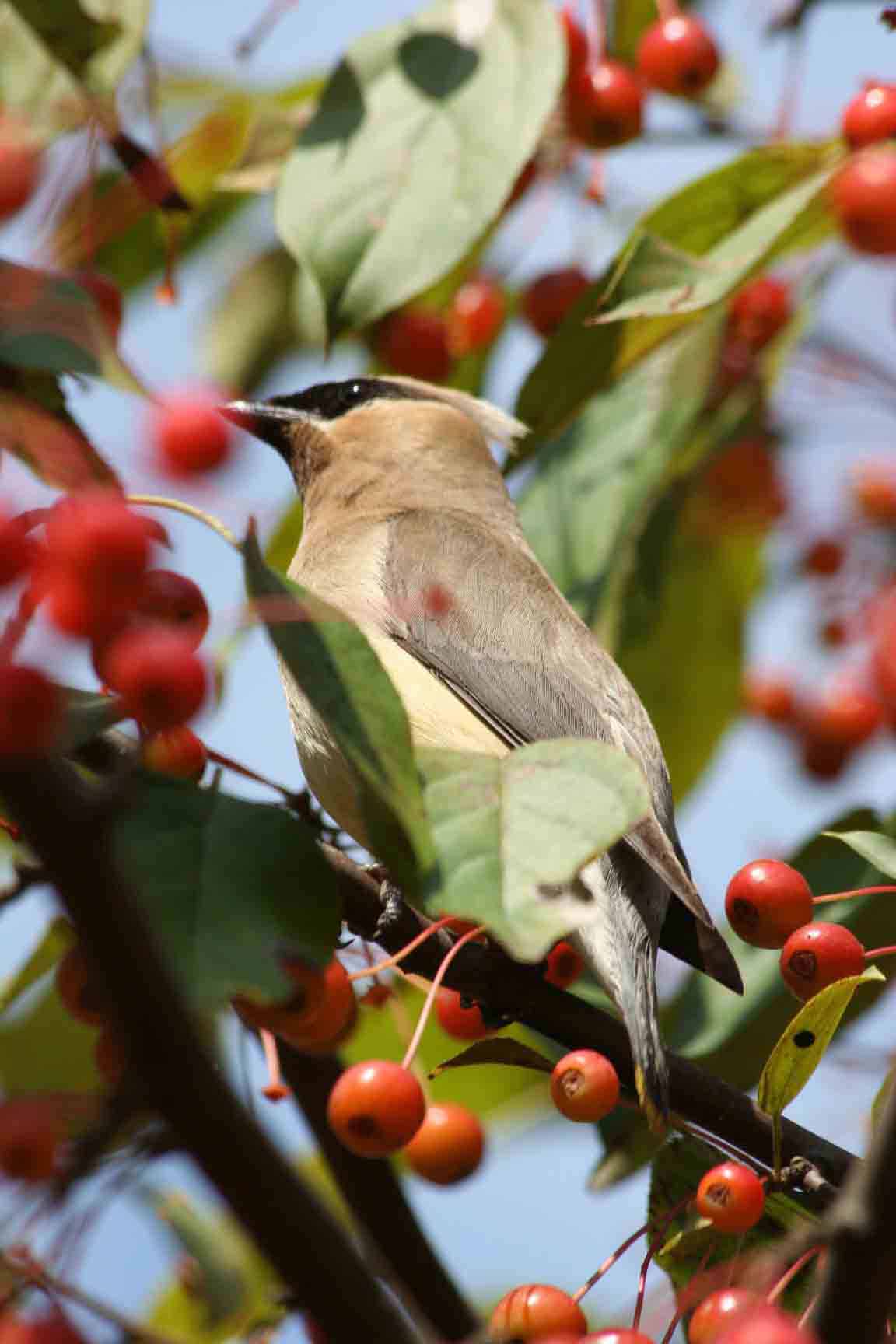 Winter birding at NYBG is always a delight. Once the deciduous trees have shed their leaves all is visible. Streaks of winter sun embrace the Forest and ignite the trees in deep silhouettes and wonderful brown hues. There is something about the frosty sunlight that brings out the vibrant color of the birds. The red-bellied woodpecker’s cap glows in red amber as the bird climbs a tree barking for attention. The northern cardinals are so brilliant in the sun as they sit on the bare branches—their red and orange feathers a sharp contrast to the white snow and brown tree stems. Even the blue jays’ cerulean feathers glow like a Matisse as the birds peck around the snow for morsels to eat.
Winter birding at NYBG is always a delight. Once the deciduous trees have shed their leaves all is visible. Streaks of winter sun embrace the Forest and ignite the trees in deep silhouettes and wonderful brown hues. There is something about the frosty sunlight that brings out the vibrant color of the birds. The red-bellied woodpecker’s cap glows in red amber as the bird climbs a tree barking for attention. The northern cardinals are so brilliant in the sun as they sit on the bare branches—their red and orange feathers a sharp contrast to the white snow and brown tree stems. Even the blue jays’ cerulean feathers glow like a Matisse as the birds peck around the snow for morsels to eat.
Perhaps the most spectacular sight in winter are the ducks on the Bronx River. White-and-crimson-orange hooded mergansers bob in the gentle flow of the river, their white heads parallel to the white snow on the river’s banks. The female with her spiked burgundy head is a sharp contrast and a delight to watch as she dives under the water searching for food.
Cedar waxwings dressed in yellow, red, and beige with a black mask pop yellow, red, and purple crabapples off the branches and into their beaks, making the perfect palette of color come alive.
Tiny black, gray, and white chickadees dance on the sweet gums’ brown sticky seed balls, pecking inside for the last of the autumn treat. Flocks of white-throated sparrows dance in the oak leaves on the ground, hopping back and forth in efforts to dislodge a hibernating spider from its berth. It is a well-choreographed movement that can be played in one’s mind to Beethoven’s Fifth.
One of the great joys of winter birding is hand-feeding chickadees. It is at this time of year that the chickadees, tufted titmice, and occasionally a cardinal are apt to land in one’s outstretched palm if you offer black oil sunflower seeds or roasted peanuts. The birds need the food for nourishment and to keep warm during the cold days of winter. Chickadee use a technique of shivering to keep their body temperatures high enough to survive and the protein from the sunflower and peanuts give them the fuel to perform the shivering technique.
Red-tailed hawks, Cooper’s hawks, and sharp-shinned hawks are also quite visible as they quietly sit on a branch waiting to pounce on their next victim.
In the quietness of the snow, in the shadows of the winter sun, the birds often reflect the silence of the season with a warm melody of song.
Check out Saturday’s programming
Check out Sunday’s programming













 Winter birding at NYBG is always a delight. Once the deciduous trees have shed their leaves all is visible. Streaks of winter sun embrace the Forest and ignite the trees in deep silhouettes and wonderful brown hues. There is something about the frosty sunlight that brings out the vibrant color of the birds. The red-bellied woodpecker’s cap glows in red amber as the bird climbs a tree barking for attention. The northern cardinals are so brilliant in the sun as they sit on the bare branches—their red and orange feathers a sharp contrast to the white snow and brown tree stems. Even the blue jays’ cerulean feathers glow like a Matisse as the birds peck around the snow for morsels to eat.
Winter birding at NYBG is always a delight. Once the deciduous trees have shed their leaves all is visible. Streaks of winter sun embrace the Forest and ignite the trees in deep silhouettes and wonderful brown hues. There is something about the frosty sunlight that brings out the vibrant color of the birds. The red-bellied woodpecker’s cap glows in red amber as the bird climbs a tree barking for attention. The northern cardinals are so brilliant in the sun as they sit on the bare branches—their red and orange feathers a sharp contrast to the white snow and brown tree stems. Even the blue jays’ cerulean feathers glow like a Matisse as the birds peck around the snow for morsels to eat.